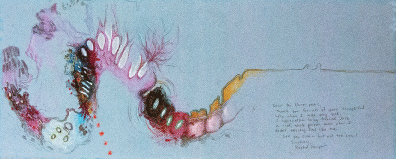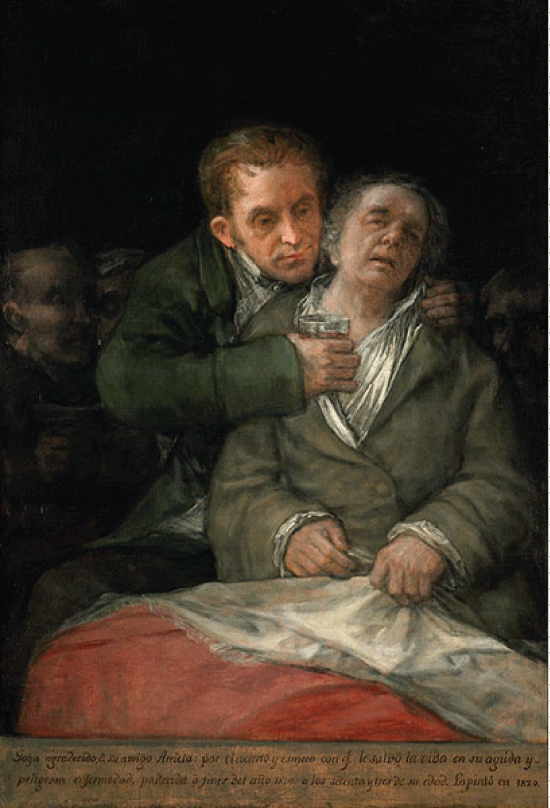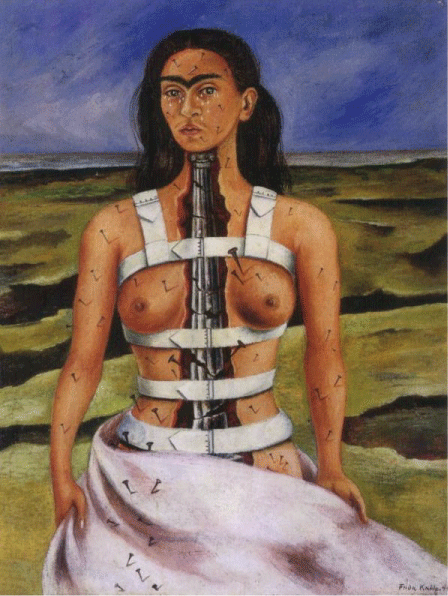Colitis from an Artist's Prospective
Abstract
It is widely understood that art expresses human experience to an audience. The viewer is provided with a unique form of insight when art is created by individuals depicting their own disease. Artists from Michelangelo to Frida Kahlo have used art as a creative outlet during times of pain and illness in their lives. In this essay, a drawing presented by the artist Rachel Harper to her physician after a serious acute attack of colitis is used to analyze the works meaning and the purpose of its creation. Expressions of illness by other artists are explored. This leads to a discussion of the use of art in the practice of medicine. The authors conclude that healthcare providers can benefit significantly from the understanding of the art of their patients.
Prospective
Rachel Harper is an artist with ulcerative colitis, an idiopathic chronic inflammatory bowel disease characterized by episodes of abdominal pain, diarrhea and gastrointestinal bleeding, followed by periods of remission. While Harper was recuperating from a hospitalization for a serious flare of ulcerative colitis, she created a work entitled, "Card" and presented it to her physician (Figure 1). The colon in the piece is depicted as complex and tortuous. Her depiction of the colon uses multiple bright colors to suggest a moving, hot, aching and diseased object. As the view moves from the left to right side of the picture, a clear reference to healing is observed, as the colon becomes more regular. Harper has said that the two nodes towards the far right of the picture represent the patient communicating about her future with her physician.
When asked what she meant to express in the picture, Harper said, "This particular object was not made to communicate with an 'outsider'. It was made to interconnect with someone who, during a moment of crisis and struggle, I perceived to be more of an insider to my experience". Her physician was "more important to the restoration of the good and whole life I once knew, than any other person on earth". Thus, this work is an expression of her experience, but also serves as a direct communication with her physician about their shared experience of her illness. This reminds the viewer of the contrast between the human emotion and pain associated with a well understood and studied illness. This piece explains Harper's connection with her physician, and her idea that, "sudden sickness made me like an infant: I could not understand my experience except in terms of pain and love". This suggests that Harper felt a physical and psychological dependence on the physician to heal her. "Card" therefore, is a representation of her bond with her physician, an explanation of the meaning behind this bond, and a representation of the disease itself.
When examining this piece, it is helpful to make historical connections to the work. Of note, the picture is drawn on coarse cardboard. This is reminiscent of later works of the Swiss artist Paul Klee. Klee suffered from scleroderma, a connective tissue disease affecting skin and internal organs resulting in significant morbidity and mortality and sometimes leading to progressive immobility. At later stages of his illness, Klee employed "coarser mediums like poster paints, and rough materials such as burlap and newspaper" [1]. These changes, along with simplified technique and forlorn titles of his works suggest themes such as Klee's anguish regarding his illness and personal misfortunes. Nonetheless, in later years, he developed resilience and conquest over his condition [2]. Like Klee, Harper chooses a textured medium for her drawing, which extenuates the pain and discomfort of her illness.
Although it is difficult to find other examples of representations of colitis, Frida Kahlo also depicts in her arthur own internal medical dysfunctions [3,4]. Kahlo had chronic sequelae of a childhood polio infection and the after-effects of a near fatal bus accident [4,5]. In the piece "The Broken Column", Kahlo is shown with a post supporting her body, that is opened via an unevenly cut wound. The column is disconnected and vaguely represents the artist's malformed spine (Figure 2). Kahlo and Harper exhibit their ailing organs openly, to express their unseen illnesses [6]. Harper's colon and Kahlo's spine share another similarity in that they are presented without context in the rest of the picture. In Harper's picture, the colon exists on its own against a blank background. Though Kahlo does show her body around the column, the spine is not connected to other organs and stands alone and essentially independent against an empty desolate background [3]. Harper's disconnected colon separates her from others both by the nature of her illness and her physical isolation inside the hospital.
Other artists have also created works of appreciation to their physicians. The inscription of Francisco Goya's, "Self Portrait with Dr. Arrieta" reads, "Goya, in gratitude to his friend Arrieta: for the compassion and care with which he saved his life during the acute and dangerous illness he suffered towards the end of the year 1819 in his seventy third year" [7]. This painting, depicting the sickly artist being physically supported by his administering doctor, was also created as a gift (Figure 3) [8]. Like Harper's art, the message was meant to express something only to the physician, as the painting was presented personally to Dr. Arrieta. Further, the dark figures in the background of this work convey a separation of the physician and patient relationship from all others in the scene. Goya's work mirrors Harper's desire to express a secret message only shared between patient and physician. Other works of art that have been presented out of gratitude to physicians. Vincent Van Gogh presented a portrait and two other paintings to Dr. Felix Rey, who cared for him following his hospitalization for self-mutilation of his ear [9]. Frida Kahlo created the painting Self Portrait with the Portrait of Dr Farill in 1951 and dedicated it to the surgeon who performed multiple operations to preserve the bone graft in her leg [10].
Discussion
Current applications in medicine
The creation of artistic works in the healthcare environment has biologic and psychological ramifications. Existing information in this area is limited and future research is required for a full understanding of the effects of art in the clinical setting. However, it is known that creativity can stimulate the release of endorphins. Endorphin release, in turn may enhance the patient's immune system, decrease inflammation and produce a sense of well-being [11,12]. Seeking this type of healing, art therapy combines the creation of art by patients experiencing illness, with the interpretation of its meaning. In art therapy, a "skilled professional attends to the individual who is making the art. This person's guidance is critical to the success of the therapeutic process" [13]. With the help and instruction of an art therapist, a patient is encouraged to create art for the aforementioned benefits of the creative process. The artistic work then serves as a conduit to aid in communication about issues the patient may be facing [14].
Creating art can help "as a way of staving off entropy and maintaining structure" in the patient's life [15]. In the elderly, involvement in artistic endeavors has been shown to increase social interaction among peers. In addition, involvement in creative expression creates a sense of control over their life. Creative activities can enhance brain function by creating new neuronal synapses [16]. Women with chronic illness and disability have been shown to experience an increase in optimistic attitudes, positive self-image, contributing to others. Planning additional art projects also creates a positive outlook for the future [17].
The apparent beneficial effect of ongoing art creation by well-known artists that have been ill has also been noted. Pierre-Auguste Renoir suffered from arthritis in his old age. This "obliged the artist to have cotton taped to the palm of his hand so as to be able to hold the brush". Nonetheless, he continued to produce paintings, "that radiate youthful joy, and took delight in representing children, young women, and the flowers of spring" [2]. Even when an artist is not expressing optimism, as in the case of Goya's "black pictures", art may still afford its creator the opportunity to, "vent to the deepest despair and mistrust in all things human" [2]. Thus art may serve as an avenue for the expression of emotions too extreme to be vocalized by the artist.
Exploring the artistic expression of a patient is consistent with a trend to incorporate humanism and empathy into nursing practice. In fact, nurses have been encouraged to analyze art in order to better understand patient suffering [18]. This approach has been advocated to counteract difficulties that nurses have in addressing the emotional and spiritual needs of patients [19]. In one study, students were shown the art work of Kahlo in order to address, "human experiences such as pain, disability, illness, loneliness, hospitalization, miscarriage and emotional distress". Nurses who participated in the study expressed a strong desire to aid the ailing Kahlo [3]. In a similar study, elderly patients and their nurse care-givers were shown masterworks of art in order to bridge differences in perception about the experiences of illness and create understanding [20].
The creation of art and use of art therapy techniques (termed "art interventions") have also been studied in children undergoing cancer treatment. A recent systematic review suggests that art interventions have a number of beneficial effects. These include reduction of anxiety, fear and pain. Art activities also enhance communication and collaboration with healthcare providers [21]. Incorporation of arts programs in the adult hospital inpatient settings have also been shown to decrease pain medication use and reduce hospital length of stays [22]. Beneficial effects of the addition of arts programming short-stay medical-surgical units include improvement in quality of care and positive attitudes of healthcare providers [23].
Healthcare providers must develop an empathetic view of their patients and connect with their experiences by understanding their emotional states. In the case of Harper's work, her physician was visually made aware of her discomfort, pain and suffering, but also her hope for the future. A physician may rely primarily on a scientific understanding of the physical and psychological manifestations of the disease process. A new level of perception allows for a humanistic perspective on their patients' experiences with pain and illness. Understanding artistic expression of illness gifts healthcare providers with an opportunity to connect with patients based on understanding and empathy.
References
- Varga J (2004) Illness and Art: The Legacy of Paul Klee. Current Opinion in Rheumatology 16: 714-717.
- Weisz GM, Albury WR, Matucci-Cerinic M (2014) SSc and the 2013 diagnostic criteria: the case of Paul Klee's manual pathology and dysgraphia. Clin Rheumatol 33: 1671-1674.
- Sandblom P (1987) Creativity and Disease. (4th edn), West Washington Square, George F Stickley Company, Philadelphia.
- Budrys V (2013) Frida Kahlo's Neurological Deficits and her Art. Prog Brain Res 203: 241-254.
- Courtney CA, O'Hearn MA, Franck CC (2016) Frida Kahlo: Portrait of Chronic Pain. Phys Ther.
- Darbyshire P (1994) Understanding the Life of Illness: Learning through the Art of Frida Kahlo. ANS Adv Nurs Sci 17: 51-59.
- Park MP, Park RHR (2004) The Fine Art of Patient-Doctor Relationships. British Medical Journal 329: 1475-1480.
- Katz JT, Khoshbin S (2014) Self Portrait with Dr. Arrieta and the Medical Profession's Tenuous Status in the Public Eye. Open Forum Infect Dis 2.
- Khoshbin S, Katz JT (2015) Van Gogh's Physician. Open Forum Infect Dis 2.
- https://www.fridakahlo.org/self-portrait-with-the-portrait-of-doctor-farill.jsp
- Smith J, Stock H, Bingaman S, et al. (2007) Low-dose Naltrexone Therapy Improves Active Crohn's Disease. Amer J Gastroenterol 102: 820-828.
- Pomorska DK, Gach K, Janecka A (2014) Immunomodulatory effects of endogenous and synthetic peptides activating opioid receptors. Mini Rev Med Chem 14: 1148-1155.
- Malchiodi CA (2007) The Art Therapy Sourcebook. (1st edn), McGraw Hill, New York.
- Uttley L, Scope A, Stevenson M, et al. (2015) Systematic review and economic modelling of the clinical effectiveness and cost-effectiveness of art therapy among people with non-psychotic mental health disorders. Health Technol Assess 19: 1-120.
- Zausner T (1998) When Walls Become Doorways: Creativity, Chaos Theory, and Physical Illness. Creativity Research Journal 11: 21-28.
- Cohen GD (2006) Research on Creativity and Aging: The Positive Impact of the Arts on Health and Illness. Generations 30: 7-15.
- Reynolds F, Prior S (2003) A Lifestyle Coat-hanger': A Phenomenological Study of the Meanings of Artwork for Women Coping with Chronic Illness and Disability. Disabil Rehabil 25: 785-794.
- Khademi M, Mohammadi E, Vanaki Z (2016) A grounded theory of humanistic nursing in acute care work environments. Nurs Ethics.
- Hayes B, Bonner A, Pryor J (2010) Factors contributing to nurse job satisfaction in the acute hospital setting: A review of recent literature. J Nurs Manag 18: 804-814.
- Hodges HF, Keeley AC, Grier EC (2001) Masterworks of Art and Chronic Illness Experiences in the Elderly. J Adv Nurs 36: 389-398.
- Derman YE, Deatrick JA (2016) Promotion of Well-being During Treatment for Childhood Cancer: A Literature Review of Art Interventions as a Coping Strategy. Cancer Nurs 39: E1-E16.
- http://legacy.arts.ufl.edu/cam/documents/stateofthefield.pdf
- Sonke J, Pesata V, Arce L, et al. (2015) The effects of arts-in-medicine programming on the medical-surgical work environment. Arts Health 7: 27-41.
Corresponding Author
Eli D Ehrenpreis, MD, E2Bio Consultants, 2906 Central Street, Evanston, Illinois 60201, USA.
Copyright
© 2017 Ehrenpreis JE, et al. This is an open-access article distributed under the terms of the Creative Commons Attribution License, which permits unrestricted use, distribution, and reproduction in any medium, provided the original author and source are credited.







